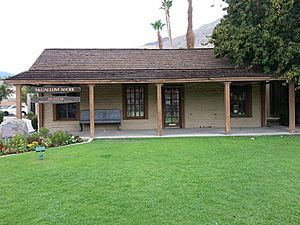Cornelia White House facts for kids
Quick facts for kids Cornelia White House |
|
|---|---|

The house, seen in 2012
|
|
| General information | |
| Status | Complete |
| Address | 221 South Palm Canyon Drive |
| Town or city | Palm Springs, CA |
| Country | United States |
| Coordinates | 33°49′15″N 116°32′49″W / 33.8208°N 116.5470°W |
| Construction started | 1893 |
| Completed | 1893 |
| Owner | Palm Springs Historical Society |
The Cornelia White House is a very old wooden house in downtown Palm Springs, California. It was built in 1893 and is one of the oldest buildings still standing in the town. This historic house is part of the Village Green Heritage Center, a special place that helps preserve the history of Palm Springs.
Contents
The Cornelia White House Story
The Cornelia White House was built in 1893. What makes it special is that it was made from "recycled" materials. The wood used to build the house came from old railroad ties. These ties were once part of the Palmdale Railroad.
What was the Palmdale Railroad?
The Palmdale Railroad was a small, horse-drawn train line in Palm Springs. It was a "narrow gauge" railroad, meaning its tracks were closer together than regular train tracks. The railroad ran along what is now Farrell Drive. It was supposed to go to a town called Palmdale, near Mount San Jacinto.
However, this train line did not last long. By 1893, it was no longer used because there wasn't enough water for the steam engines. The tracks were taken up, and the wood was used to build the Cornelia White House.
Who was Cornelia White?
The house is named after its first owner, Cornelia B. White. She was an important early settler in the Palm Springs area. Pioneers like Cornelia White helped build the first communities in the region.
Village Green Heritage Center
The Cornelia White House is located right next to another historic building called the McCallum Adobe. The McCallum Adobe was built even earlier, in 1884. It was the home of John McCallum, who was the first European American settler in the area. It was also the first successful adobe (a type of brick made from earth and straw) building in the upper Coachella Valley.
Since 1961, both the Cornelia White House and the McCallum Adobe have been managed by the Palm Springs Historical Society. They are now known together as the McCallum Adobe-Cornelia White House Museum.
Visiting the Museum
Today, these historic houses are open to the public. Visitors can explore them and see other items from Palm Springs' past. For example, you can see some of the earliest telephones used in the town. The museum is located at 221 South Palm Canyon Drive in Palm Springs. It's a great place to learn about the early days of the city.


